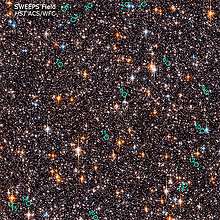MINERVA-Australis
MINERVA-Australis is a dedicated exoplanet observatory[1], operated by the University of Southern Queensland, in Queensland, Australia. The facility is located at USQ's Mount Kent Observatory, and saw first light in quarter two 2018. Commissioning of the facility was completed in mid-2019, and the facility was officially launched on 23 July 2019.[2]
The facility follows the innovative model first deployed in the northern hemisphere's Miniature Exoplanet Radial Velocity Array (MINERVA)[3], a northern hemisphere exoplanet facility located at the U.S. Fred Lawrence Whipple Observatory at Mt. Hopkins, Arizona. MINERVA-Australis is being used to perform follow-up and characterisation observations of exoplanets discovered by NASA's Transiting Exoplanet Survey Satellite, TESS, which was launched in April, 2018.
The project's principal investigator is USQ astronomer Rob Wittenmyer, who leads a consortium of partners from institutions across the world (UNSW Australia; Nanjing University; University of California, Riverside; MIT; George Mason University; University of Louisville; University of Texas at Austin; University of Florida).
Science objectives
The primary mission of MINERVA-Australis is to support observations carried out by the NASA TESS spacecraft, providing dedicated follow-up and characterisation of newly discovered exoplanets. During commissioning, the facility has been used to pursue targets of opportunity, and to carry out work extending the baseline of the Anglo-Australian Planet Search program. MINERVA-Australis allows researchers to obtain precise radial velocity observations for target stars, enabling the masses of planets discovered by the TESS spacecraft to be directly measured, and has recently demonstrated a radial velocity precision of approximately 1 m/s.
In addition to providing high precision velocity measurements, MINERVA-Australis will also offer high-cadence photometric observations. This is to facilitate direct follow-up transit observations of TESS candidate planets (particularly those in fields from which TESS has moved on). It can also enable the observation of occultation events and other transient targets-of-opportunity.
During commissioning, observations made by the MINERVA-Australis array contributed to the discovery of 13 new exoplanets, working in collaboration with researchers at institutions across the globe.
The facility
MINERVA-Australis is to consist of six PlaneWave CDK700 telescopes[4], of which five are installed and functional as of 23 July 2019. These 0.7 m telescopes have two ports, allowing each to be used for either spectroscopic or photometric observations. Each telescope sits in its own automated clam-shell Astrohaven dome[5], distributed in an approximate semi-circle around the main observatory building.
Photometric work is to be carried out using Andor cameras[6], with 2k x 2k back illuminated CCDs with 15 µm pixels. These cameras offer an effective field of view > 20'.
The six telescopes is to be connected by optical fibre to a stabilised, R = 75,000 echelle spectrograph with an iodine cell, designed by KiwiStar Optics. The first results from the facility are impressive, and demonstrate that the facility is working at the expected level of precision.
See also
References
- "Details of funding for the MINERVA-Australis project, from the Australian Research Council". Archived from the original on 2 August 2017. Retrieved 4 December 2017.
- "We have lift-off: USQ at forefront of planet discoveries". University of Southern Queensland. 23 July 2019. Retrieved 22 September 2019.
- The homepage for MINERVA, a dedicated northern hemisphere exoplanet observatory.
- Technical specifications for the PlaneWave CDK700 telescopes, six of which will make up the MINERVA-Australis telescope array.
- Details of Astrohaven's 12' domes. MINERVA-Australis uses six of the slightly larger, 12.5', domes to house its six telescopes
- Details of the Andor iKon-L 936 camera, to be used by MINERVA-Australis.

